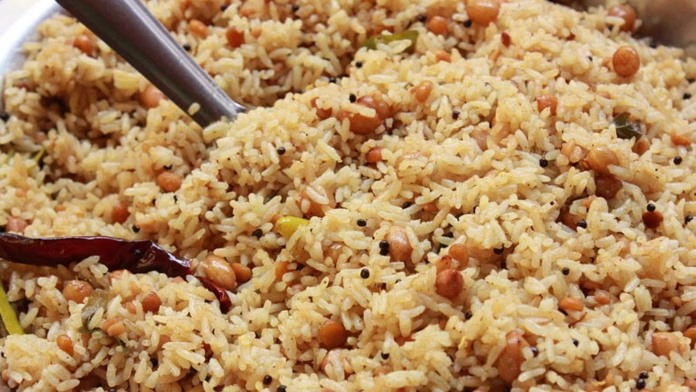Puliyogare, puliyodarai, pulinchoru, kokum rice or Pulihora is one of the things that binds all five south Indian states together, as they all share the culture of tamarind rice in common.
The preparation of Pulihora varies from region to region and even from family to family. Some people prefer to use freshly grated coconut, while others use roasted sesame seeds, groundnuts, or fried onions as a garnish. Some people also add vegetables such as carrots, green peas, and potatoes to the dish to make it more wholesome and nutritious.
Not only this delicious dish binds people culturally, it even is easy to make and can even be made as a meal-prep and stored in advance making it very convenient, making it the first choice of your South Indian mom for your tiffin box for school and even giving it off for a long train journey.
A plate of hot, steaming rice, infused with the tangy and flavorful taste of tamarind and spices is not just a food but a hug from your mother when you reside outside. As you take a bite, the burst of flavors and textures is a treat for your senses. The crunchy peanuts, the fragrant curry leaves, and the roasted cashews all come together to create a symphony of flavors in your mouth making it the best comfort food of any South Indian guy.
So, whether you want to prepare it for your loved ones or simply because we made your mouth water, here’s a recipe that might come in handy if you have the following:
Ingredients:
- 2 cups of cooked rice
- 3 tablespoons of tamarind paste
- 3 tablespoons of vegetable oil
- 1/4 teaspoon of turmeric powder
- 1 teaspoon of mustard seeds
- 1 teaspoon of cumin seeds
- 2 red chili peppers
- 1/4 teaspoon of asafetida powder
- 1/4 cup of roasted peanuts
- 10-12 curry leaves
- Salt to taste
For the Tamarind Paste:
- Soak the tamarind ball in 1 cup of hot water for 10-15 minutes.
- Squeeze out the pulp and strain the mixture to get a smooth tamarind paste.
Instructions:
- In a pan, dry roast chana dal, urad dal, coriander seeds, cumin seeds, mustard seeds, fenugreek seeds, and dry red chillies until they turn golden brown.
- Remove from heat and let it cool down to room temperature.
- Grind the roasted spices into a fine powder and keep it aside.
- Heat oil in the same pan and add asafoetida and curry leaves.
- Add the tamarind paste and let it cook for a few minutes until the raw smell disappears.
- Add the spice powder and salt to the tamarind paste and mix well.
- Add the cooked rice to the pan and mix well with the tamarind paste.
- Add the roasted peanuts and mix well.
- Your Puliyogare is ready to serve!
You can garnish Puliyohara with roasted cashews, roasted sesame seeds, or grated coconut. Serve it with raita or papad for a complete meal.
Puliyogare is a good source of carbohydrates, providing energy to the body. It also contains protein and healthy fats from ingredients like peanuts and sesame seeds. Puliyogare is also rich in sodium, which can help replenish electrolytes lost through sweat. Additionally, the dish provides a moderate amount of fiber, vitamins C and A, and minerals like calcium and iron making it top choice of anyone who wants to live a healthy lifestlye.
This dish is also perfect for lazy and health conscious people as it can be made in even simplest ways and is even for students who want to live a healthy lifestyle. So, next time when someone says that healthy food is boring, stuff their mouth will spoon ful of puliohara.





